Active Galactic Nuclei
374-381
When we pause to consider the sheer size, mass and distance of galaxies the word "normal" seems out of place. However, as we shall soon see, some members of the galactic community are very strange indeed. These differences manifest themselves in a number of ways and astronomers have reserved the term peculiar galaxy to label a significant number of these "oddball" galaxies. In all cases these galaxies exhibit very active nuclei and another useful classifying term is Active Galactic Nuclei or AGN.
Seyfert Galaxies
First discovered by Karl Seyfert in 1941, these are often normal looking galaxies with very bright and at times variable nuclei (AGN's). Nuclei are typically 10 000 x brighter than the core of our own galaxy with total luminosity about 10 x that of our galaxy. Radio observations suggest that the nucleus is typically less than a light year across. Spectra show broad emission and absorption at the core indicating violent turbulent motion. Most energy emitted in either the radio or infrared part of the spectrum.
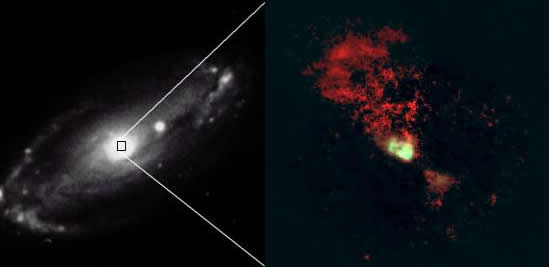 |
All indicators point to violent explosive activity in the galactic nucleus. Seyfert galaxies can also exhibit high redshifts. Figure 14.1 shows a NASA-HST image of the nearby Seyfert galaxy NGC 5728. Observation indicates that there are two broad categories of Seyfert Galaxies:
|
| Figure 14.1 Seyfert Galaxy NGC 5728. Image on left is an Earth-based view, box is a Hubble close-up of the nucleus showing a compact, energetic source. | |
- Type 1: very luminous in the X-ray and UV part of the spectrum with very broad emission lines in their spectra.
- Type 2: weaker X-ray and UV emission and much narrower emission lines
There is some evidence that links Seyfert galaxies to galactic collisions are very good evidence that the cores of Seyfert galaxies contain supermassive black holes.
Double-Lobed Radio Galaxies
Similar to Seyferts but most energy emitted in radio region and emanating from distinct lobes often extending many kpc from the galactic core. Typical Luminosity: 1036W - 1038W = 1 - 10 X our galaxy.
These galaxies exhibit strong jet structure and energetic, small nuclei. Figure 14.2 shows the double-lobed galaxy NGC 4261 - a remarkable object with a possible black hole at the nuclear center which feeds the enormous radio jets thrusting vertically above and below the galactic plane.
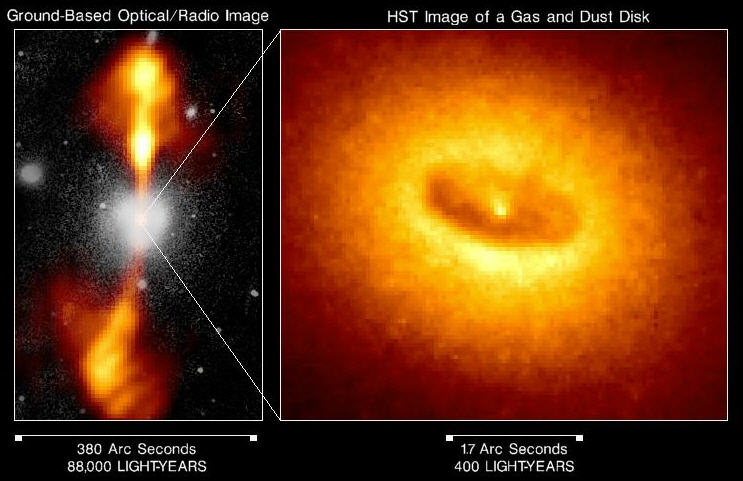 |
| Figure 14.2 Double-Lobed radio galaxy NGC 4261 (Image courtesy NASA - HST/STScI) |
Evidence for the black hole is provided by the high resolution view of Hubble seen in the image on the right in Figure 14.2. Measurement of the rotational velocity of the gas in this region indicates the presence of a very massive, compact core.
BL Lacertae Objects
Once thought to be variable stars, these peculiar galaxies are now recognized to be very active radio galaxies. Sometimes called blazars, they may be radio-lobe galaxies viewed lobe on.
Quasars
| Discovered in the early 1960's these are among the most energetic of AGN's. Quasars have high red shifts implying that they are very distant, and extremely luminous (average quasar is 1000 x as bright as our galaxy). Quasars are also variable in output on time scales of a few hours to days. Figure 14.3 shows a Hubble image of the distant quasar PKS2349 which appears to be merging with a companion galaxy. The typical luminosity of a quasar is 1038W - 1042W = 10 - 100 000 X our galaxy. We will discuss quasars in greater depth in the he next section. | 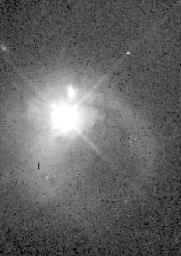 |
| Figure 14.3 Quasar PKS2349 |
Table 14.1 summarizes Common Features of AGN's
|
|
|
|
|
| Table 14.1 |
How Radio Lobes Emit Energy - Synchrotron Radiation
The campus of the University of Saskatchewan houses the Canadian Light Source (CLS) one of the most sophisticated, high energy light sources in the world. The Canadian Light Source and radio-lobed galaxies both use the same underlying physics to produce intense beams of electromagnetic waves! Figure 14.4 shows the interior of the CLS.
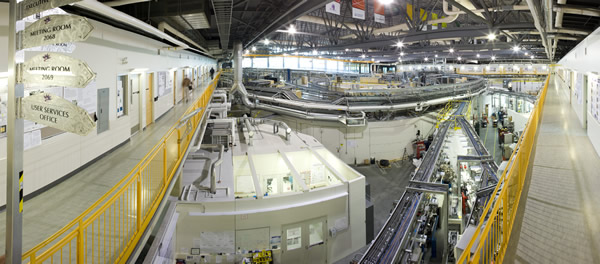 |
In this instrument electrons are accelerated to close to the speed of light and then deflected by strong magnetic fields and made to curve into circular paths.Any time a rapidly moving charged particle is deflected it emits a continuous range of electromagnetic waves. This is called synchrotron radiation. |
| Figure 14.4 The Canadian Light Source in Saskatoon. This world-class research facility produces high energy photons via the same synchrotron process used by radio-lobe galaxies! |
Figure 14.5 illustrates this for an electron traveling along a helical path in a magnetic field. As it does so it continuously emits electromagnetic waves. As the electron approaches the speed of light this beam becomes more concentrated into a cone facing the direction in which the electron moves.
In radio lobed galaxies intense beams of charged particles are projected as bipolar flows out of the galaxy. The beams travel through the galactic magnetic fields and in the process emit synchrotron radiation. As you saw in Chapter 10.4 supernova remnants are also places where synchrotron radiation is an important way in which energy is emitted. Synchrotron radiation is usually easily distinguishable because it has a very different spectral distribution than the black body-like emission from most stars. In order to produce synchrotron radiation a mechanism must exist to accelerate charged particles to very high velocity. We will consider this now. |
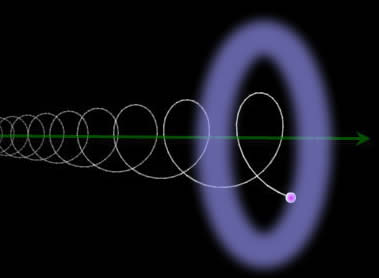 |
| Figure 14.5 Synchrotron emission of light by an electron accelerating in a helical path in a magnetic field. |

Supermassive Black Holes in the Hearts of AGN's
What provides the energy to propel charged particles in the cores of AGN's to nearly the speed of light? The answer seems to be supermassive black holes! There is considerable evidence that points towards black holes as one of the most important "engines" in astrophysics. Black holes provide two critical conditions for the radio jets seen emanating from AGN's:
Figure 14.6 depicts a black hole accretion disk and particle beam. |
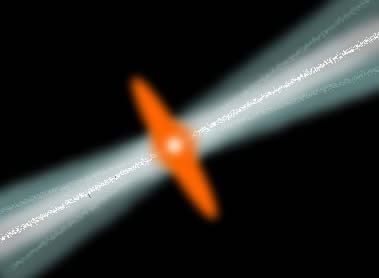 |
| Figure 14.6 Artist's conception of an accretion disk and particle beam at the core of an AGN |
Example 14.1 Radio emission from AGN's can sometimes be observed to vary on time scales of only a few hours. Explain how this would help support the claim that supermassive black holes of the energy sources for AGNs.
Solution: Recall that the minimum timescale for an object to vary in brightness equal to its diameter divided by the speed of light, or the maximum size of an object is its time of variation times the speed of light. This means that whatever provides the energy in an AGN cannot be more than a few "light-hours" across - roughly the size of our solar system.
How Big are the Supermassive Black Holes in AGNs?
The mass of the supermassive black hole at the centre of an AGN can be determined if it is possible to measure the orbital velocity around the centre of the galaxy as well as the radius of the central region. If you apply what you learned in Chapter 4.5 then you can easily determine the mass. To assist you an applet-calculator is provided in Figure 14.7.
For example, Figure 14.2 shows a Hubble image of the central region of NGC 4261. The central mass has a radius of 400 ly and spectroscopy shows that the gas is swirling around the core with a velocity of about 200 km/s. Example 14.2 Use the Black Hole Mass calculator to assist you in determining the mass of the black hole at the centre of NGC 4261. Solution: By inserting the appropriate numbers you can easily verify that the mass of the black hole at the centre of NGC 4261 is 1.2 billion solar masses! |
|
| Figure 14.7 |
The Unified Model for AGN's
Table 14.1 summarizes the most significant properties common to all AGN's. The central, unifying idea in understanding AGN's is the supermassive black hole and accompanying jet structure created by the black hole. How the black hole's accretion disk is oriented with respect to us helps explain some of the subtleties that distinguish one kind of AGN from another. This is called the unified model for AGN's.
Example 14.3 How does the unified model explain the two types of Seyfert galaxies?
Solution: The distinction is likely due to seeing the supermassive black hole accretion disk from different angles.The following figure shows two different orientations. If the accretion disk is seen edge on (left image) then the brightest and hottest portion of the disk will not be visible. An observer would see only the cooler, outer part of the disk and jet. This is likely what happens when you are looking at a Type 2 Seyfert galaxy.
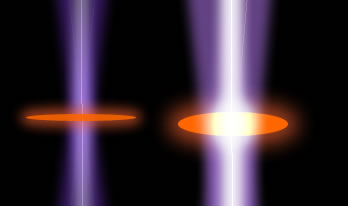 |
The outer, cooler parts of the accretion disk will be fainter and show narrower spectral lines than the hotter interior regions. |
Practice
- What evidence is there that Seyfert galaxies have had recent interactions with other galaxies?
- Why is it that some radio galaxies show two equal intensity lobes whiles others show very different intensity lobes or only one lobe?
- The central region of an AGN measures 100 ly across and the orbital velocity of gas in this region is 600 km/s. Estimate the mass of the central black hole.

To understand what Active Galactic Nuclei and how they indicate the role of supermassive black holes in the working of galaxies.
Chp 17.1


